Back to writings
IN SEARCH OF A STYLE
LEARNING TO PAINT AFTER NATURE, 1972-1980.
Always I have painted. In the early years I hardly ever tried to reproduce what was in front of me; all was fantasy.
On the schools I went to the teachers asked for paintings with titles like ‘spring colors’, ‘music’ or ‘future’.
In 1972 I wanted to get more serious and went to an evening drawing course. All but one disciplines were about learning to draw after nature. There I made the first steps.
One teacher taught me maybe the two most important lessons of all: modesty and the will to sacrifice all well drawn pieces if they stand in the way of a good total result. I learned that everything has to do with everything and that a work cannot be constructed like a jig saw puzzle, adding piece after piece. First you have to build a vague overall shape. Afterwards you can ‘hang in’ the details.
Amongst other we drew portraits with charcoal on paper. To my bewilderment the teacher wiped all carefully drawn eyelids that were swimming in an egg shaped monster to a fruitful mist with a big handkerchief. From this mist the details could appear in the right position and right balance.

‘Portrait study’, charcoal on paper, 1973.
During the same period I frequented the school of furniture making. There I learned two other important lessons. For weeks I’d prepare shelves and boards that by gluing them together turned into a cupboard in only a couple of hours. Sometimes you have to be patient.
And maybe it gave me a more spacious insight.
I went to the Rietveld academy with the idea of becoming an interior designer. It was there that painting got a hold of me; no escaping from it. I mostly painted after nature. Giving it a twist was of secondary importance. It was vital to learn to reproduce the surrounded reality. Learning the trade was still my aim.
The confrontational critics, the endless discussions and the camaraderie of the fellow students helped.

Drawings made at the Rietveld Academy, 1975-80.
The last two years of that academy I followed courses at the State academy in the evenings. There I had to produce a colour sketch painting of a model in only three hours. I made me more accurate. I discovered that the longer you doubt and think, the worse the painting gets.

Gouaches made at the State Academy, 1978-80.
ITALY, BREAKING LOOSE FROM PAINTING AFTER NATURE, 1980-1986.
After the academy I went to Italy for three years. I felt quite somebody. I had followed several courses. I had a diploma, but what can that mean when it is one for the arts? I fell flat on my face. Nobody was waiting for me and matters were dealt with differently. Paintings were not made in the way I was used to. I was praised for my Flemish style (In the beginning I build my paintings up in a manner similar to the one used by Rubens), but these comments were only meant to glorify the one who made them.
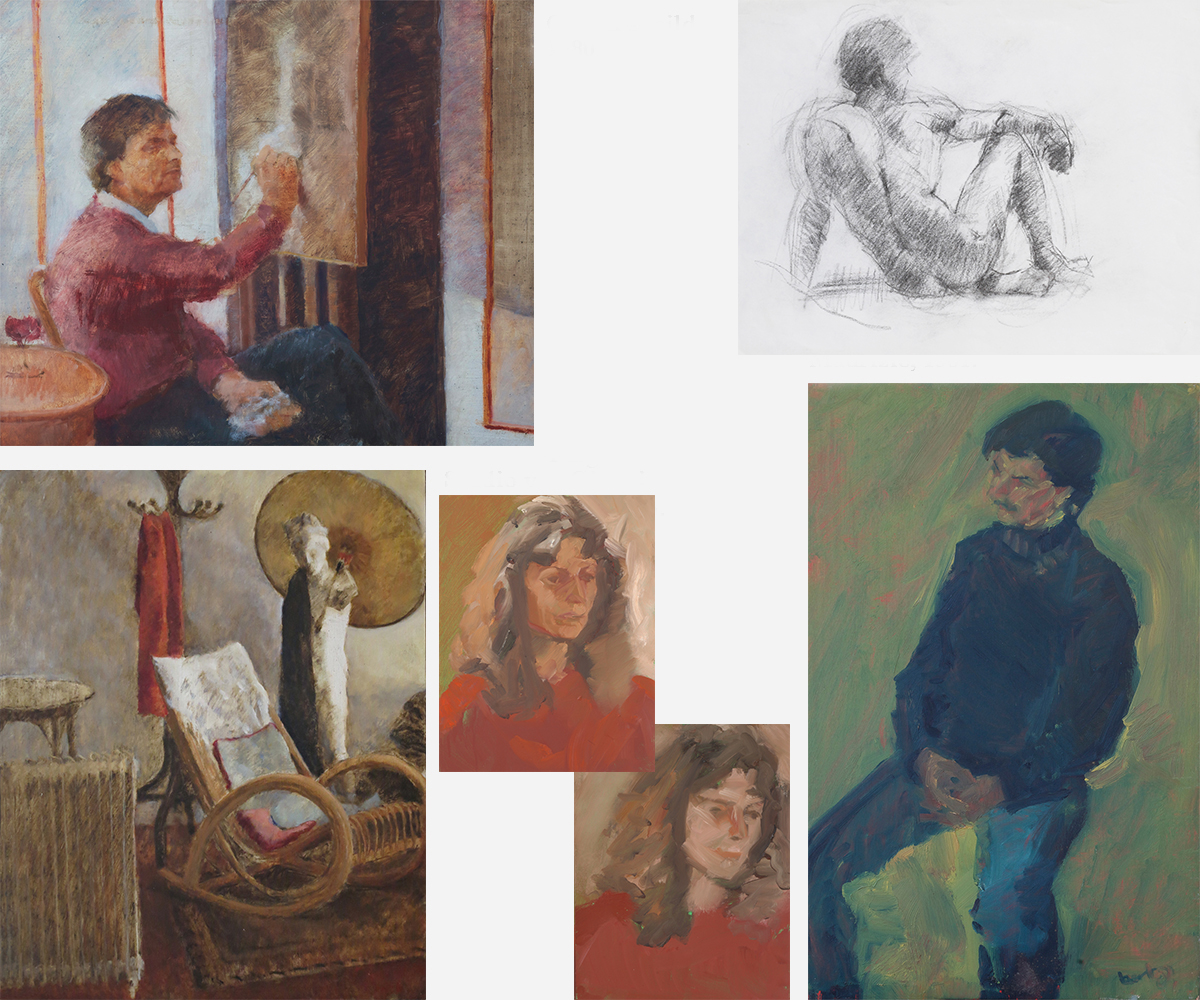
Clockwise: 'Gianni working in his studio’, oil on panel, 1980, ‘Model sketch of Paolo’, charcoal on paper, 1982, one of the first portrait assignments: ‘Maurizio’, oil on panel, 1981, two preparative sketches for a ‘Portrait of Isabella’, oil on paper, 1982, ‘Gianni’s studio’, oil on panel, 1980. Read the text about my Italian adventure by clicking on one of the images above.
There I found two comrades in arms: Gianni and Mikolash. Gianni is a real Florentine and Mikolash is a fugitive from the Prague Spring in 1969. Their works differ much from mine. We started a model drawing class. Very good was to see that with a different way of working others came to a good result as well.
I thought to have studied enough to break loose from the faithful representation of images and go for a more personal view.
Being able to faithfully represent nature is the basis on which one can build an image with a solid personal twist. First you have to be able to ‘speak the language’ of imagery. And reality can surprise you; the sky is not always blue, a skin is not always pink…
Even after many years it is still good to every once in a while go for the representation of things in a realistic way. It keeps you fit and agile. It can open new doors.
At the same time I looked at how and why the geniuses twisted reality. I studied the masters of the Renaissance and Baroque. It has strengthened me and given again modesty. When I’d proudly show a new painting the reaction often was; ‘not bad, but what about Giotto, Ghirlandaio, Botticelli, Caravaggio, Luini, Raffaello Sanzio, Michelangelo, Da Vinci’ and so on…
The big adventure could start now.
A break through was a painting in which first I painted a model and afterwards painted myself behind. It was a horribly bad work of which I fortunately have no image.
I experimented in all kinds of directions. Cubist, abstract, symbolic, expressionist, you name it… but the big question in the end is, why diverse from the faithful realistic image?
A thought presented itself. A painting shows a moment in time. To brake through that is impossible. Still, I wanted to find a way to represent time and movement.
And a painting is flat. There is no third dimension. It can be suggested and I wanted to focus on that too.
Dance is about movement and space. Maybe there I could find something.
I went to a dance school and rehearsals of a theatre group. There I had the feeling everything slipped through my fingers. There was no way of making a natural representation, so I sometimes fled in almost futurist sketches.
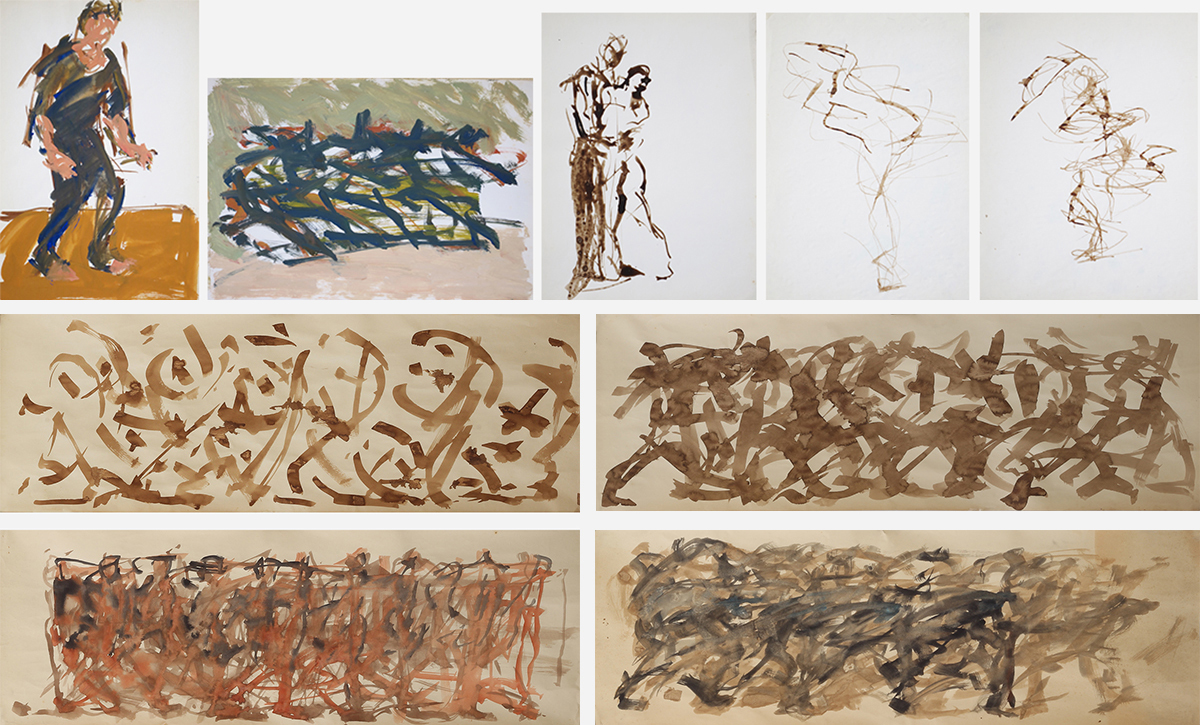
Sketches of dancers, mixed media on paper, 1981-82.

Sketches of a theatre group, mixed media on paper, 1982.
Back in the Netherlands I produced the first painting of a reasonable quality in 1986. In a story on the site I talked about Sareeta; this painting was homage to her. The painting is more dynamic than the sketch that I used as a starting point. The image has drifted reasonably far away from reality, but still has enough credibility of it’s own. This was the start of a personal handwriting in which the brush stroke has an important role.
A painting should not only be interesting because of the twist that has been given to the subject, also the ‘language’, the way it is painted, has to be special. You could say that the painting has to be painted ‘spicy’.
I got on track by looking at the late Rembrandt paintings. And maybe Rembrandt had looked at the late works of Titian. With Titian they speak about ‘la pittura di macchia’. It means that his images were built up making loose brush strokes like spots, sometimes neglecting the shapes of objects. It gives the painting a dynamic feel and makes it livelier.
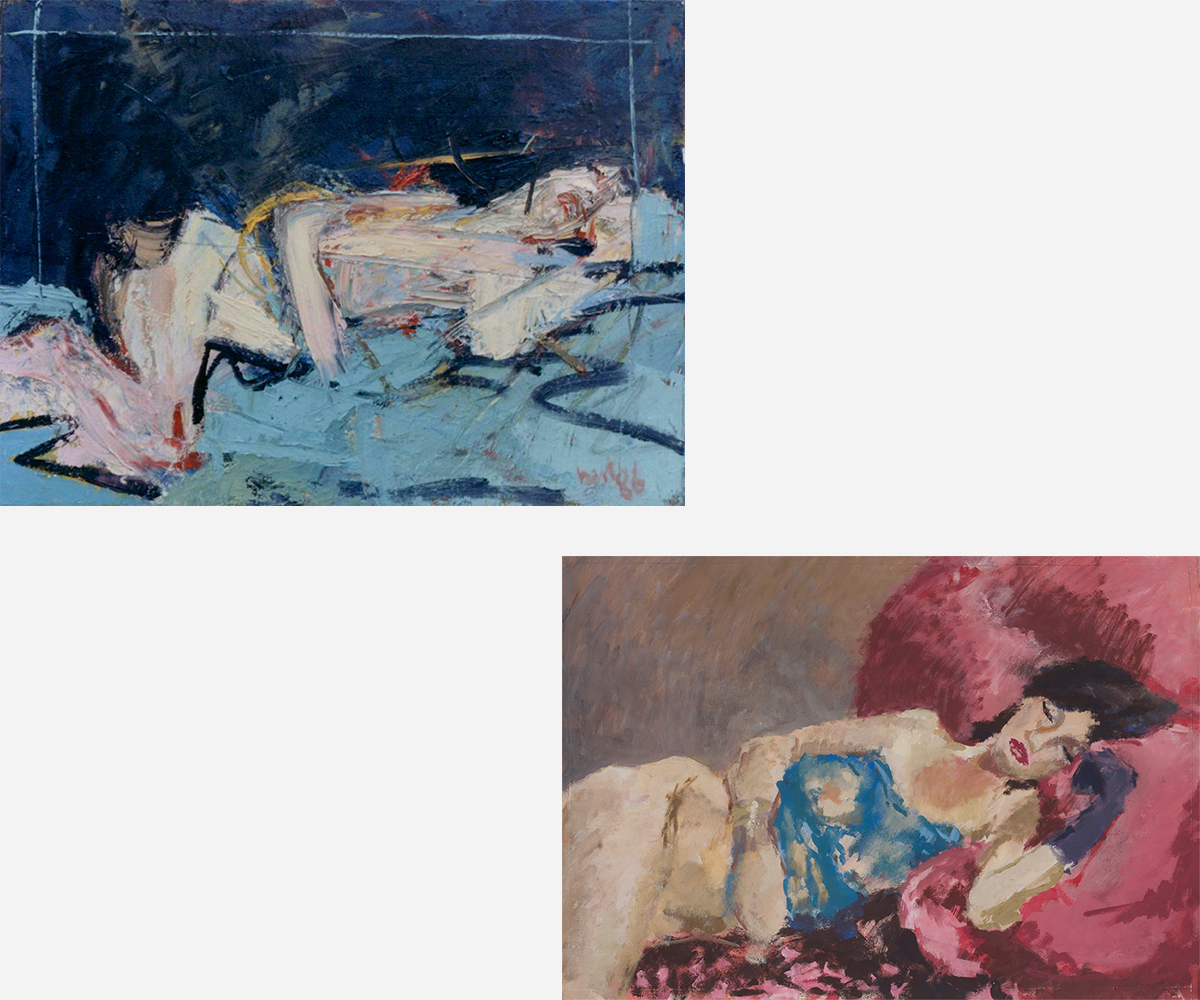
Left: 'Sareeta', oil on canvas, 1986, right: 'Sareeta', gouache on paper, 1979. Click on the image to go to the story about Sareeta.
I was back on Dutch soil with my feet dug deep in the mud. England was nearby. The 'London School' gave me a lot. Next to the works of Francis Bacon, the ones of Frank Auerbach were a great source of inspiration.
FINDING AN OWN HANDWRITING, 1986-1990.
I made a step forward in the following year: ‘From Tongue to Crutch’ and ‘The Trench’. It was the ‘zigzagging’, ‘combining’ and ‘continuing’ between and on other's painter's works that appealed to me, that made clear where my challenges and possible solutions lay. The Futurists had helped me as far as finding a way to represent movement, but because they praised the mechanical movement and not a more emotional and human, their solution led to a dead end street for me. The broken spaces invented by the Cubists helped me to depict time and movement. By Francis Bacon I found the ‘sensual fleshiness’. Of course there were many more paintings by other artists and made in other styles that inspired me, but in this period my interests narrowed to what really touched and concerned me.

'From Tongue to Crutch' and 'The Trench', both oil on canvas, 1987-1988.
The following big jump forward took place between 1989 and 1990. In 1989 I had a show in Milan at the studio of De Giorgi. Significant works there were ‘Not Tonight’ (a portrait of my then relation made without her modelling), ‘The Foot’ and ‘Approaching Fire’. In this period it could happen that I got so far off track from the original subject and/or the initial idea; that I had to add a new canvas to find the solution. See ‘Not Tonight’.
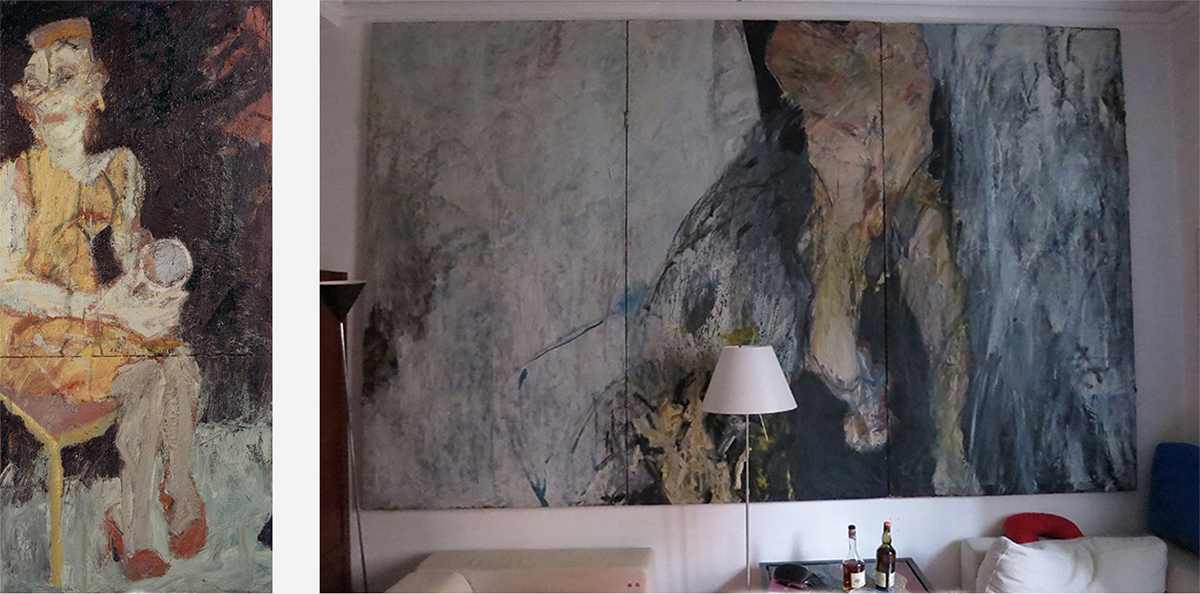
‘Not Tonight’, oil on canvas, 1989, ‘Approaching Fire’, oil on canvas, 1989.
In 1990 there was the exhibition in Amsterdam at Jaski Art Gallery. The period in which I found out what painting for me was about significantly coincided with the illness and passing away of my mother. This event may have triggered the idea that I had no one more to guide or safe me, no one more ‘above’ me. I realized that I was left on my own, so I had to speak out clearly. On show were: ‘The Shield’ (maybe the first really outspoken work), ‘Spit and Rain II’, ‘ The Kites’ and ‘The Three Brothers’.

Clockwise: 'The Shield’, oil on canvas, 1989, 'The Kites', oil on canvas, 1990, 'Spit and Rain II', oil on canvas, 1990, 'The Three Brothers', oil on canvas, 1990.
THE TRANS ATLANTIC LIGHT, NEW YORK, 1991-1993.
I left for New York. Next to the ‘old classics’ I could study the ‘new’: Rothko, De Kooning, Johns, Rauschenberg, Warhol en Pollock. I had flirted with them, now it was serious business. I experienced the hardness of the Trans Atlantic light, I felt the pace and mentality of New York. Colours became brighter, contours sharper.
Even there I felt no attraction towards abstract painting. I had explored this direction in the past, but in the end found it too meagre. For me there is no challenge in what I find the ‘anything goes’. I have no belief in what is called ‘pure painting’. Everything is rooted in the surrounding world or/and is a reaction to it. Besides, I love what I call the ‘sensual fleshiness’, the presence of a living organism.
Because I was sure enough about my handwriting, I started to concentrate more on the continence of my paintings. I started to make series with the same subject. The series ‘My Metropolis’ took shape. This is a series of combined portraits, referring to the skyscrapers of Manhattan.
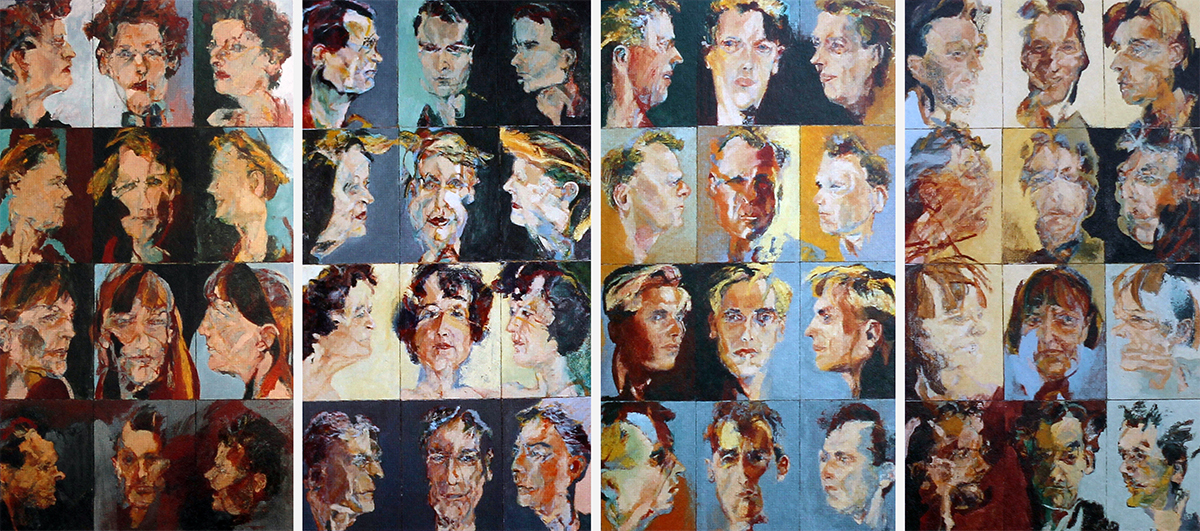
Some more works painted in New York:

'New Life Red', oil on canvas, 1992, 'New York Life Green', oil on canvas, 1992. Click on 'New York Life Red' to read more about the paintings made in New York.
Looking back, I realize that the works of Willem de Kooning were the most precious to me, thanks to his way of putting paint on the canvas.
FALLEN ANGELS, ANOMALOUS SHAPES AND THE USE OF DIFFERENT MATERIALS, AMSTERDAM, 1993-1997.
I returned to Amsterdam in 1993. From my stay in New York I inherited the theme 'Fallen Angels'. In this series the idea of the whole and the adornment (the frames and the placing on the wall) were essential.
The works were made with gouache, chalk and pencil on paper. With these materials I had more freedom and because the works were part of a 'closed' series, I could explore better the outskirts of how to represent the human figure in a horizontal position.
Click on the image below to read the text about the ‘Fallen Angels’.

Presentation of a group of 'Fallen Angels', mixed media on paper in frame, 1995.

3 'Fallen Angels', mixed media on paper, 1995-97.
I started to work with anomalous shapes of a painting and found out that apart from the shapes that belong to our collective memory, they lead away from a satisfying result. They disturb too much. Only the crucifix as a form has survived.
Also, I tried to integrate other materials into paintings several times, this to divert from the traditional use of just paint. This too did not satisfy in the end. I want to keep a painting pure. Using other materials can lead to escapism and/or indolence. Two paintings survived…

'Venus in the Reed', mixed media on paper and reed in coffin, 1993. 'Attempt to Fly', oil on canvasses, 2004.
HANDS, MONUMANTALITY AND CONSOLIDATION, 1993-1999.
At the age of 8 I suffered from ‘nightmares’ just before falling asleep. Giant cushions would slowly creep over my face. Only at the last moment before choking the cushion passed and immediately a new one would cover my face. My bed would float through the room and my tongue and thumbs became huge. In 1982 the same dream occurred to me. I wanted to represent this dream of massiveness in a painting.
That same sensation I saw in the works of Picasso between 1921 and 1925.
I started to paint hands. The hand is a vital part of the body and yet can be anonymous. The idea came from a sketch called ‘ Hand imitates Mouth’ made in New York. I made a painting of it.
Subjects overlapped and fertilized each other. And example is ‘The Tub of Fools’.
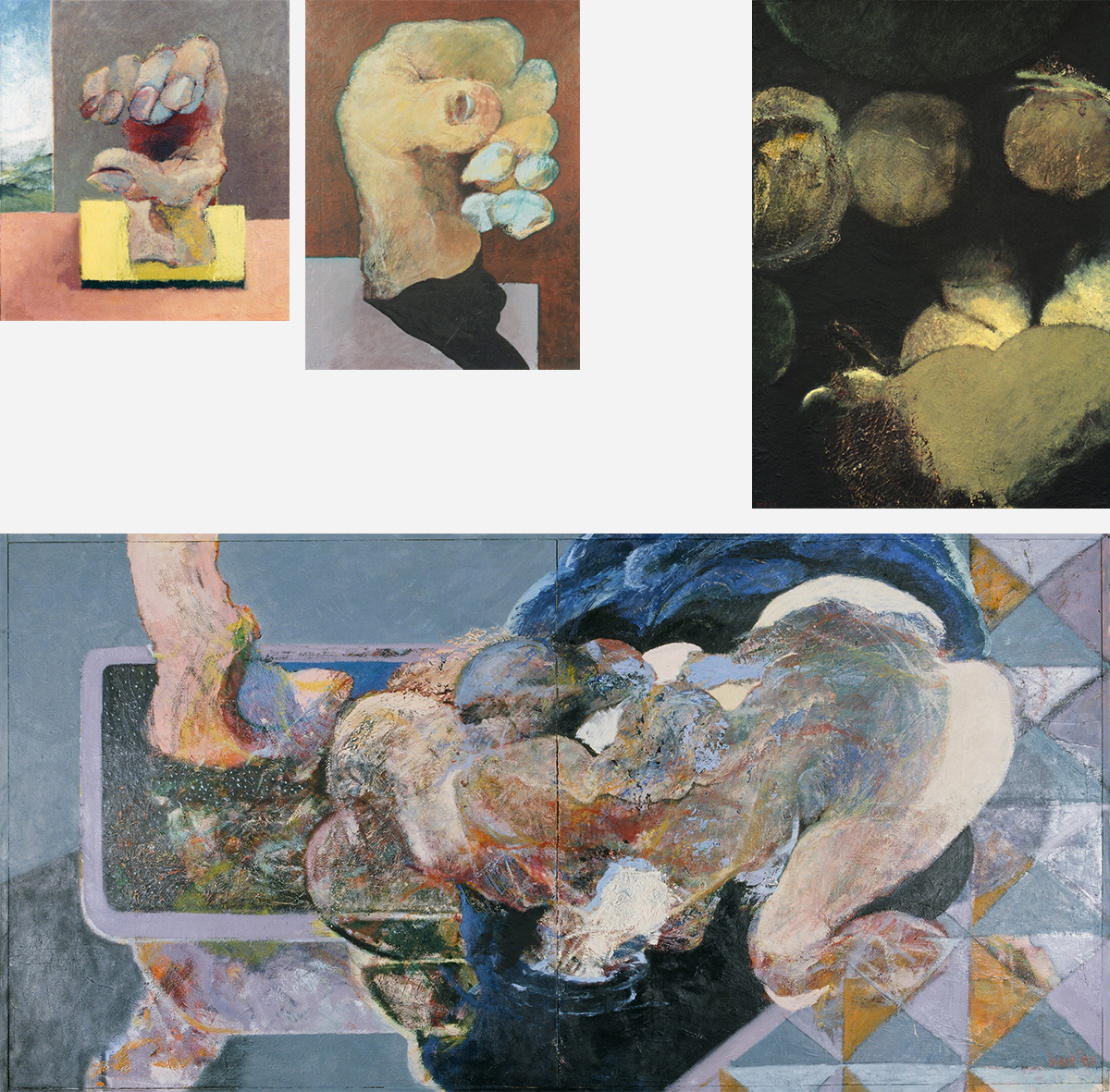
Clockwise: ‘Hand imitates Mouth’, oil on canvas, 1993, ‘Hand scatters his Nails’, oil on canvas, 1994, ‘Hand and Sphere’, oil on canvas, 2000, ‘ The Tub of Fools’, oil on canvas, 1995.
This sense of monumentality I still use when I paint portraits. The size of the portrait is always bigger than the real and the canvas is small, so it fills about the whole canvas.
All different surroundings and influences still echo through in my work, but in the end I feel a hopeless ‘mud-and-clay Amsterdammer’. Often Rembrandt comes for tea…
Looking back, the first solid footprint in the mud was made in 1990. In New York and the 4 following years I made the most decisive steps. Everyone finds his own ‘pool’ to ‘swim’ around in, touching than this then that board. I am still learning, but the territory in which all takes place is mostly delimited.
BARCELONA, 1999-N0W.
In 1999 I left for Barcelona. The city and its culture have no big influence on the way I work. Already I had found solid ground underneath my feet. This can be seen clear thinking that after 2001 I often found the definite shape of a model drawing after the model had left. I ‘improved’ the drawing; I found a more ‘plausible’ image.

Model sketches from 2001 on, mixed media on paper.
In Spain I found a new subject: the bullfight. Here too time through movement and space play an important role. And the theme is profound.
Furthermore Barcelona and surroundings have little to offer me.

‘Bullfight 036’, oil on canvas, 2008, ‘Bullfight 024’, oil on canvas, 2004, ‘Bullfight 063’, oil on canvas, 2014. Click on the images of bulls to go to the text about the bull and bullfight.
THE USE OF PHOTOS, YET A NEW WAY OF WORKING, 2010-NOW.
The recent alteration in how to paint took place in 2010. You can see this in my ‘flower’ paintings. In these works I explore the light-dark effect, typical for the so by me loved Baroque.
For the explanation I have to take a few steps back. Somewhere halfway the nineties I visited an exhibition of watercolours made by Emil Nolde. I was mesmerized by the strength of the colours. This and a painting of Raffaello Sanzio (seen in 1987) in which there is a ruby that seems to give light, made me curious if I could obtain the same result. It lasted till 2010 before I made my first gouaches of fantasy flowers. With this technique I let the white of the paper play an important role.
Eventually I tried the same in oil on canvas. In order to let the white play its role, I had to completely change the build up of a painting. All had to be planned carefully instead of improvising and painting layer over layer. Once the white is covered there is no way back. I used photos as a lead in some parts.
Already I had used photos for portraits, but had never been able to fit them into the process in a really satisfying way. At the academy using photos had been considered a sign of weakness. Even though the use of these technical aids goes back as early as 1430. First by using the ‘camera obscura’, later by newer means. And Francis Bacon made good use of them. I have finally found the right balance.
I feel fortunate to have learned to paint mostly from the real. It has given me the awareness that one sees with two eyes. It gives us the capacity to see and possibly create depth, for me one of the great challanges.
And to work from a living model standing in front of you is a huge difference (and privilege) from working with photos.

‘Flower 009’, oil on canvas, 2012, ‘Flower 036’, oil on canvas, 2017, ‘Flower 037’, oil on canvas, 2017.
With this new step my wish to create an oeuvre in just one style belongs to the past. Now I find the reason of how to paint in the subject that I want to represent and what I wish to achieve.
I have understood that all theories that serve to produce ‘solid’, ‘innovative’ and ‘epochal’ works belong to the past. No style can improve or refute an older one. The adventure in this way makes no sense whatsoever.
My definition of ‘style’ and the search for it:
A style does not come by searching for it, thinking about how one should paint a priori. A style may find its shape thanks to the to be painted subject and what one desires to show with it. Style has to do with fighting one's own incapacities; a personal style exists in finding more or less the same solutions over and over again, trying to do the impossible. By trying to overcome one's limited talents. The search and doubt are the most important. The rest comes on it’s own. One has a style or one has not. This is for others to decide.
I allow myself to move in any direction the painting asks me to.
Who knows what the future may still bring…

Recent works made in the same time period (2004-18).
Barcelona, May 2018.
Back to writings



















